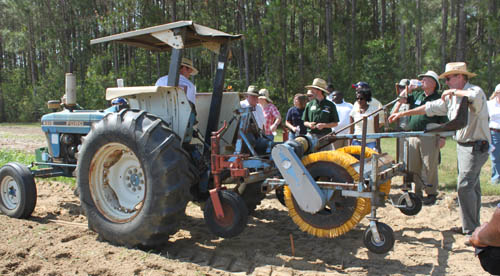Outsmarting weeds in organic crop production sometimes requires unorthodox, or what Carroll Johnson calls “bizarre” management techniques.
At the University of Georgia’s Principles of Integrated Weed Management in Organic Crop Production Workshop in Tifton, Ga., June 22, people got a glimpse of one of those unusual tactics: a brush-hoe in a peanut field.
Sweep weeds away
The power-driven implement, fitted with stiff bristles, scours the surface of the dirt as the peanut crop emerges, disrupting any potential weed germination. The technique seems to work, said Johnson, a USDA-Agricultural Research Service and UGA agronomist.
A week after using the brush-hoe on one experimental plot produced a weed-free peanut row. A plot that didn’t get brush-hoe was weedy.
The brush-hoe may not be the right fit for every farmer, but many different methods exist for controlling weeds in organic crop production. From cultivation to cultural to organic products, participants of the UGA workshop got a crash course in integrated weed management. The Southern Sustainable Agriculture Research and Education, or SARE, Professional Development Program supported the workshop.
Slice, disrupt and bury
The morning began with a tour of the UGA Tifton Ponder Farm, where a variety of cultivation techniques – meant to slice, under-cut, bury or disrupt weed seedlings -- were demonstrated. These methods included a sweep cultivator, a tine weeder and the brush-hoe. USDA-ARS Auburn University researcher Ted Kornecki demonstrated various ways to manage cover crops using rolling technology.
“Cover crops in organic production are a weed-prevention strategy,” said Julia Gaskin, UGA sustainable ag coordinator for Southern SARE. “But one of the biggest challenges to using cover crops is finding the right cover crop that fits your rotation and accomplishes your specific purposes.”
If you see it, you're too late
Afternoon sessions at the Tift County UGA Cooperative Extension Office included winter and summer cover crops for weed suppression; modifying crop production practices to help suppress weeds, such as planting dates, crop selections, row spacings and seeding rates; the role of hand weeding; and using organic herbicides to control weeds.
“The goal of the program is to introduce a systems approach to weed management,” Johnson told attendees. “The saying goes that if you see a weed, then it’s already too late.”








